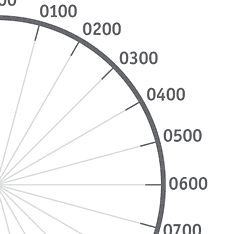Lesson 1: How to Tell the Time and Date
Teach students the basics of telling time and recording dates in various formats.
Your content has been saved!
Go to My Saved Content.Download Lesson 1 (68KB)
Scientists record times and dates to keep track of events, for organization, and to spot any patterns or relationships in data. Start molding your students into young scientists by teaching them the basics of telling time and formatting dates.
Before starting the lesson, give students some background about the NatureMapping program. Explain that they'll be studying various animal species, and they'll be completing the NM data-collection form in order to help create a biodiversity database used by scientists and the general population. Also, hand out field journals in the beginning, which students will use to record their observations throughout the project.
Lesson Objectives and Materials
Objectives
Students will
- understand the difference between digital and analog clocks.
- learn how to tell time in standard and military notation.
- understand different date formats, including the NM standard of MM/DD/YYYY.
Materials
- NM data-collection form
- 11-by-14-inch paper
- Analog and digital clocks or watches
- Pens and pencils
- Calendars
- Field journals (bound scientific notebooks)
- Live specimens, such as a caterpillar or a gerbil
Telling Time
Prelesson Preparation: Make copies of a clock that you've separated into 24-hour segments on 11-by-14-inch paper.
In this part of the lesson, you will teach students the difference between analog and digital time and show them how to tell time in standard and military notation. Follow these steps:
- 1. Explain the difference between analog and digital time using different watches or clocks as examples.
- 2. Explain military time and coverting from standard time to military time.
- Military time operates around a 24-hour clock that starts at 12 a.m. (0000) and goes to 11 p.m. (2300). It does not have notations for "a.m." and "p.m."
- Times are presented in four-number increments -- two digits referring to hours and two digits referring to minutes.
- To complete the format, add 12 to times from 1 p.m. to 11 p.m., and add zeroes when needed to complete the four-number format. For example, 1 p.m. is 1300 and 6 p.m. is 1800.

Customization Tips
Is the lesson too advanced for your students? Here are some ways to customize the lesson for younger kids:
- Grades K-2: Ask students to record time by adding clock hands to a figure of a clock face.
- Grade 3: Ask students to record digital time on a clock they draw.
Recording a Date
The International Organization for Standardization says that the correct calendar date format is written as YYYY-MM-DD. However, date formats vary by organization and individual preferences. Here, you will teach students the many ways they can write a date, including the format NM uses.
Follow these steps:
- 1. Ask students to write today's date on the chalkboard in all the ways they can think of. Here's a nonexhaustive list to refer to when adding ideas to the students' list:
- 8/29/2008
- August-2008
- Thursday, August 29, 2008
- August 29, 2008
- 8/29
- 8/29/08 6:00 p.m.
- 8/29/08
- 8/29/08 18:00
- 08/29/08
- 29 Aug
- 29-Aug-08
- 29-Aug-2008
- Aug-08
- Dictate different dates, and have students write them down in the correct format. Use whiteboards to pinpoint common mistakes quickly.
- Ask students to circle the correct date from a list.
- Have students orate names of the month in the correct order.
- Use dates that remain constant in your examples, such as Christmas and Independence Day.
- Tie in dates from other subjects, such as history, as practice examples.
- Show students how to select and format dates in a software program, such as Microsoft Excel.
- Ask students to practice using a calendar daily, inputting dates and times for assignments and events.
Practical and Assessment
Practical
Test your students' ability to record times and dates. Read dates and times out loud, and ask students to format them appropriately -- in NM format and in military units respectively.
Assessment
How did your students do? Here are some ways to assess students' abilities, reflective of grade level. Assess students by point scale or qualitatively.
- Exceeds standard: Student was able to record the time and date accurately when recited ten out of ten times.
- Meets standard: Student was able to record the time and date accurately when recited nine out of ten times.
- Below standard: Student was able to record the time and date accurately when recited eight times or fewer out of ten times; student needs more practice.
Key Points
Start generating student interest in biodiversity by providing an example of hour-by-hour and seasonal activities of an animal.
Vocabulary
We use these terms throughout this and other NatureMapping lessons:
- Analog: Continuous time. An analog clock tells time by moving hands on a clock face from hours 1 to 12.
- Digital: Specific time. A digital clock represents finite time (every tenth of a second, for example) via numbers instead of clock hands.
- Military time: A method of time keeping through a 24-hour clock, in which the day runs from midnight to midnight and is divided into 24 hours.
- Standard time: A method of time keeping through a 12-hour clock, based on the official local time of a region or country.
Related NatureMapping Activities
If you enjoyed this lesson, check out these links to additional NatureMapping materials:
Everything Is Connected: An activity that demonstrates the interdependence of living creatures to one another and their environment.